|
|
|
Sort Order |
|
|
|
Items / Page
|
|
|
|
|
|
|
| Srl | Item |
| 1 |
ID:
167398
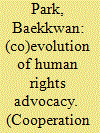

|
|
|
|
|
| Summary/Abstract |
How does the discussion of human rights issues change over time? Without advocates adopting a human rights issue in the first place, international ‘shaming’ cannot occur. In this article, we examine how human rights discussions converge and diverge around new frames and new issues over time. Human rights norms do not evolve alone; their prevalence, framing, and focus are all dependent on how they relate to other norms in the advocacy community. Drawing on over 30,000 documents from dozens of human rights organizations from 1990 to 2011, we provide a temporal overview and visualization of the ebb and flow of human rights issues. Using our new dataset and state-of-the-art methods from computer science, our approach allows us to quantitatively examine (a) how new issues emerge in the advocacy network, (b) the relationship of these new issues to extant human rights advocacy and information, and (c) how the framing and specificity of these issues change over time. By focusing on the process by which a new issue gets incorporated into the work of advocates, we provide an empirical assessment of the first step in the causal process connecting shaming to improvement in human rights practices.
|
|
|
|
|
|
|
|
|
|
|
|
|
|
|
|
| 2 |
ID:
178725
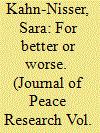

|
|
|
|
|
| Summary/Abstract |
Does it matter whether human rights (HR) shaming is accompanied by acknowledgments of reforms and progress? Do such acknowledgments weaken or strengthen the impact of shaming? Rulers decide whether to oppress or to comply with HR treaty obligations by considering what compliance entails and by weighing the internal and external costs and benefits of oppression. Research shows that HR shaming alters such considerations and is associated with changes in HR protection levels. Can the same be said of faming? This article examines three forms of HR reporting: faming, which focuses on positive developments; shaming, which focuses on problematic HR practices; and scrutiny, which combines shaming and faming. The article analyzes the association between shaming, faming, and scrutiny by UN treaty bodies, on the one hand, and oppression on the other. The potential associations are conceptualized as mitigation, backsliding, and specification. The analysis finds that shaming with no faming and faming with no shaming are each negatively associated with HR protection. Scrutiny, the combination of shaming and faming, is positively associated with subsequent HR protection levels, and the higher the level of scrutiny the higher the subsequent level of HR protection. The article argues that the reason for this association is that the combination of shaming and faming helps policymakers understand how to properly implement their treaty obligations and how to improve HR protection. The article draws policy and theoretical implications including the need for balanced and detailed HR reporting, and the importance of learning in HR advocacy.
|
|
|
|
|
|
|
|
|
|
|
|
|
|
|
|
| 3 |
ID:
196777


|
|
|
|
|
| Summary/Abstract |
Does human rights advocacy make a difference? Many are skeptical. Studies often find that advocates have an impact only under limited circumstances. I argue that these underwhelming results are a by-product of an identification problem. Research so far has effectively focused on whether shaming campaigns reduce ongoing abuse. But such cases are only part of the story. Another big aspect of advocacy is preventing abuse from ever starting. We must then pay attention to the deterred, those who chose not to violate human rights because of the threat of shaming. These cases do not repress and are never shamed. They are easy to miss because they look the same as those who never considered abuse in the first place. However, identifying deterred cases is crucial for judging the effectiveness of advocacy. I argue that we can resolve this issue by focusing on the degree of human rights monitoring in a country. Doing so allows researchers to recognize those under the scrutiny of advocates, and hence those that could have been deterred even if they were never shamed. Once we do this analytical refocus it is easy to see the positive effect of human rights advocacy. Human rights monitoring reduces abuse, and it does so in most countries.
|
|
|
|
|
|
|
|
|
|
|
|
|
|
|
|
| 4 |
ID:
184769
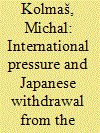

|
|
|
|
|
| Summary/Abstract |
Shaming in international relations has been extensively analysed as a normative practice that aims to persuade the target to comply with certain norms. Recently, IR scholars have identified cases, in which this process failed or antagonised the target. But although these studies have shown us how shaming works, they have not fully explained under what conditions shaming works. To remedy this, the article analyses the role of shaming in Japanese whaling controversy. In 2018, Japan announced its withdrawal from the International Whaling Commission, defying three decades of sustained international pressure. I identify two versions of shaming of Japanese whaling: premoratorium ‘soft' and post-moratorium ‘hard' shaming. The former, although less confrontational, had normative impact on Japanese society and policymaking, leading Tokyo to accept the moratorium and scale down on its whaling operations. The latter, marked by attacks of NGOs and heated discourse, had an opposite outcome and helped conservative policy entrepreneurs formulate a ‘cultural wars’ narrative that prevented the inception of anti-whaling norm. The reason for this difference, I argue, lies in Japanese domestic political culture, which played a defining role in the success/fail of shaming strategies. For shaming to be successful then, careful understanding of the target society is essential.
|
|
|
|
|
|
|
|
|
|
|
|
|
|
|
|
| 5 |
ID:
192885
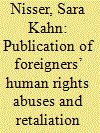

|
|
|
|
|
| Summary/Abstract |
Institutions that monitor violations of human rights, particularly of victims living outside their home countries, will often name the victims’ countries of origin in their reports. This article looks at this understudied practice and argues that it unintentionally creates bilateral retaliation dynamics between the victims’ home country and the country violating the victims’ rights. The article defines retaliation and explains why countries care about violations of their citizens’ rights that take place abroad. Through empirical analysis, the article shows that countries retaliate in response to violations of their citizens’ rights which have been identified and publicized by the UN Committee Against Torture. I use a new dyadic dataset on the abuse of foreigners’ human rights, as identified by Amnesty International and the Committee Against Torture, to test the hypothesis that a country's abuse of foreigners from a peer country is associated with that peer country's abuse of rights of citizens from the observed country. I then examine the Syrian–Lebanese case to trace the process of retaliation. These analyses support the hypothesis that countries retaliate against violations of their citizens’ rights abroad.
|
|
|
|
|
|
|
|
|
|
|
|
|
|
|
|
| 6 |
ID:
114630


|
|
|
|
|
| Publication |
2012.
|
| Summary/Abstract |
When does shaming work as an alternative to incarceration and fines in sentencing white-collar criminals? In the light of recent economic downturn and highly publicised instances of white-collar crime, public opinion has demanded harsher sentences for white-collar criminals. In order to appease this demand, as well as consider the pressing problem of prison overpopulation, alternative sanctions, such as formal shaming, have been increasingly studied. Through examination of the costs and consequences of incarceration and shaming, this article will explain that since the costs of shaming sanctions are largely fixed, shaming sanctions are most viable when used in conjunction with alternative sanctions so that courts can impose sanction bundles of costs commensurate with the level of offense committed by an offender.
|
|
|
|
|
|
|
|
|
|
|
|
|
|
|
|
| 7 |
ID:
167400
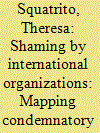

|
|
|
|
|
| Summary/Abstract |
In the face of escalating conflicts or atrocities, international organizations (IOs), alongside non-governmental organizations (NGOs), often vocalize public condemnation. Researchers have examined NGO shaming, but no extant literature has comparatively explored if, how and why IOs shame. This article fills this gap. We conceptualize IO shaming as condemnatory speech acts and distinguish between the agent, targets and actions of shaming. We theorize how compliance and socialization are motives that lead IOs to shame. Empirically, we use new data on more than 3000 instances of IO shaming, covering 27 organizations between 1980 and 2015 to examine empirical patterns across the three dimensions of agents, targets and actions. We find that the majority of IOs do employ shaming but to varying degrees. Global, general-purpose IOs shame the most and regional, task-specific IOs the least. IOs mainly shame states, but there is a rise in the targeting of non-state and unnamed actors. While many condemned acts relate to human rights and security issues, IOs shame actions across the policy spectrum. These findings indicate that IO shaming is driven by compliance and socialization motives and that it is a wider phenomenon than previously recognized, suggesting possible avenues for further inquiry.
|
|
|
|
|
|
|
|
|
|
|
|
|
|
|
|
| 8 |
ID:
164417
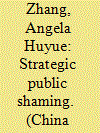

|
|
|
|
|
| Summary/Abstract |
This article examines strategic public shaming, a novel form of regulatory tactics employed by the National Development and Reform Commission (NDRC) during its enforcement of the Anti-Monopoly Law. Based on analysis of media coverage and interview findings, the study finds that the way that the NDRC disclosed its investigation is highly strategic depending on the firm's co-operative attitude towards the investigation. Event studies further show that the NDRC's proactive disclosure resulted in significantly negative abnormal returns of the stock prices of the firm subject to the disclosure. For instance, Biostime, an infant-formula manufacturer investigated in 2013, experienced −22 per cent cumulative abnormal return in a three-day event window, resulting in a loss of market capitalization that is 27 times the antitrust fine that it ultimately received. The NDRC's strategic public shaming might therefore result in severe market sanctions that deter firms from defying the agency.
|
|
|
|
|
|
|
|
|
|
|
|
|
|
|
|
|
|
|
|
|